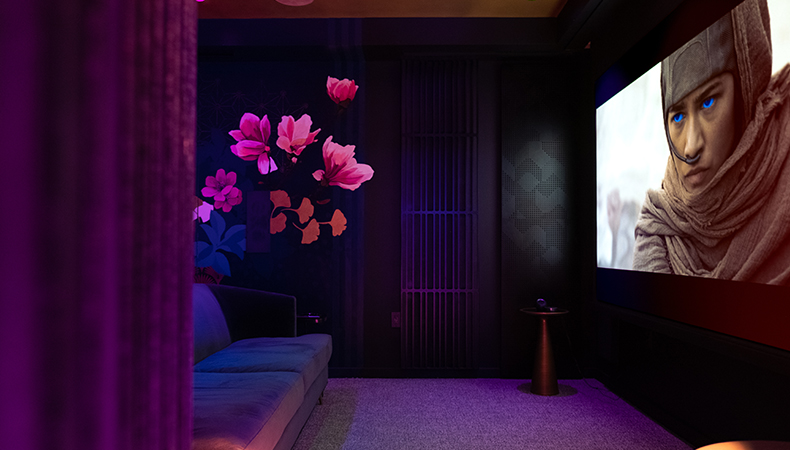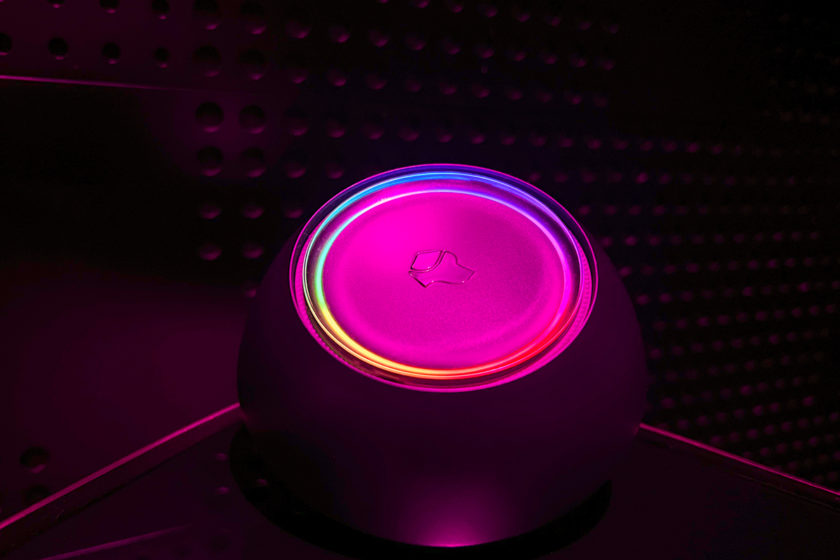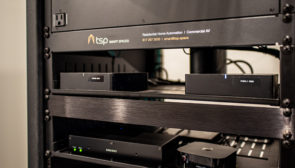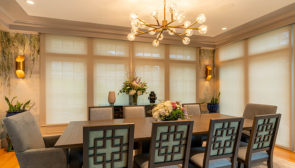The key elements of a home theater system

Imagine stepping into a room where the outside world fades away, and you’re transported into the heart of your favorite films. This is the magic of a well-designed home theater system. As the popularity of home entertainment continues to soar, more homeowners are investing in these immersive spaces. In fact, the global home theater market is projected to reach $27.5 billion by 2026, growing at a rate of 6.7% from 2021 to 2026. In this guide, we’ll explore the essential components that transform a ordinary room into a cinematic paradise.
What sets a home theater apart?
While many homes have a dedicated space for watching TV or movies, a true home theater elevates the experience to new heights. Unlike a typical living room setup or even a media room, a home theater is meticulously designed to optimize every aspect of audio and visual performance. It’s a space where every detail, from the acoustics to the lighting, is carefully considered to create an immersive experience that rivals – and often surpasses – commercial theaters.
Check out our full article on the difference between a Home Theater and a Media Room.
Key elements of a home theater system
Below, we’ll guide you through the key elements creating the immersive experience a good home theater should deliver.
1. Immersive, high-definition sound
At the heart of any great home theater lies its sound system. The goal is to create an audio environment that envelops you, making you feel like you’re part of the action on screen.
Surround sound setup:
A basic surround sound system typically includes:
– Front left and right speakers
– Center channel speaker
– Two or more surround speakers
– One or two subwoofers
For a more advanced setup, you might want to consider:
– Additional height channels for Dolby Atmos (more below)
– Multiple subwoofers for even bass distribution
Speaker placement:
Proper speaker placement is crucial for optimal sound. Work with a professional like TSP Smart Spaces to ensure your speakers are positioned correctly based on your room’s dimensions and seating arrangement.
Room acoustics:
The acoustics of your room play a significant role in sound quality. Consider adding any of the following:
– Sound absorption panels to reduce echoes
– Bass traps for controlling low-frequency resonances
– Diffusers to scatter sound reflections
Dolby Atmos:
This advanced audio technology adds a vertical dimension to your sound, creating a three-dimensional audio sphere. It requires additional ceiling-mounted or upward-firing speakers but delivers an unparalleled immersive experience.
“The artists and technicians meant for the viewer to not only hear them but to feel them. Volume and dynamics add energy and excitement but for me, the ability to recreate the intended subtleties is the mark of a truly excellent home theater.” – Chris Feterowski, Build Technician
TSP Smart Spaces integrates trusted technology from Amina, Savant, TDG Audio, and Artcoustic to ensure you can enjoy your cinematic experience as it was meant to be heard. But what we do goes far beyond just purchasing high-quality surround speakers for you. We’re helping you select the right speakers that fit your room and designing their placement and settings to maximize the space to its fullest with the best sound quality. Once we’ve created that immersive surround sound you’re looking for, we use a program called Dirac to fine-tune and optimize your speakers so every seat in the room has the same experience and no part of your room sounds worse than another.
2. Controlled lighting for optimal viewing
Lighting control is essential for creating the perfect viewing environment. Here’s how to achieve it:
Ambient light control:
– Install blackout curtains or shades to eliminate external light
– Consider a windowless room design for complete light control. Many home theaters operate in finished basements to achieve this.
Smart lighting systems:
Integrate smart lighting solutions like Ketra LED lighting, which offers:
– Dimming capabilities down to 0.1%
– Color temperature adjustments to match on-screen content
– Preset scenes for different viewing experiences (e.g., movie night, sports event)
At the TSP Smart Spaces Experience Lab, we use Ketra LED lighting. Ketra’s ability to dim to .1% across a wide color spectrum sets it apart from other smart lighting solutions. That means if you’ve set your lighting to purple to match your room’s design style, you can dim it all the way down to .1% for proper ambiance. Most commercial-grade lighting you’ll find at Lowes or Best Buy can get down to 5% or so, but Ketra can really dim so your lighting doesn’t detract from the design of the room.
3. Superior image quality

The visual component of your home theater is equally important as the audio. Here’s what to consider:
Projector vs. TV:
While large TVs are popular for media rooms, projectors often provide the best value for true home theaters, offering:
– Larger screen sizes (100+ inches)
– More cost-effective for very large displays
– A more authentic theater-like experience
When looking for the right projector for your home theater system, there’s a few things you’ll want to consider. First is whether to go with a lamp or laser model. Lamp models are much cheaper, but the image quality declines over time and you’ll eventually have to change bulbs. Laser and LED projectors cost more, but they run cooler and last up to 30,000 hours. Second, you’ll want to decide on resolution. Here, we recommend going for 4k resolution. 720p or 1080p projectors do exist and are cheaper, but you get what you pay for. And on a 100″+ screen, the difference in resolution is quite noticeable. Finally, see what special features you need to ensure your projector will work for your space. This can include HDR to give your video more dynamic contrasts, or ensuring that your projector has enough HDMI inputs for all your devices. At the end of the day, working with a smart home integrator will take the guesswork away from you and ensure your home theater projector is set up correctly. In our private cinema, Secret Cinema, we rely on a 4k JVC projector projecting on a 133″ Screen Innovations screen.
4. Smart home integration

Integrate your home theater with your smart home system for seamless control. This can allow you to:
– Use a single remote or app to control all aspects of your theater
– Automate lighting, sound, and video settings for one-touch movie nights
– Integrate with voice assistants for hands-free control.
In our Experience Lab, our home theater setup is integrated with Josh.ai, which allows us to control the entire experience through our voice. Whether that’s getting ready for a movie night, or adjusting the color of the lights to match the color of your favorite sports team playing, voice control adds a touch of luxury to an already incredible experience.
Home Theater Planning Checklist:
- Determine your budget
- Choose and prepare your room
- Plan your audio system (speakers, receiver, acoustics)
- Select your video system (projector/TV, screen)
- Design your lighting setup
- Choose control and automation systems
- Plan for proper ventilation and power management
- Select and arrange seating
- Add finishing touches (decor, snack area, etc.)
- Schedule professional installation and calibration
The crucial role of a professional integrator
While DIY home theater setups can be tempting, working with a professional integrator is invaluable when creating a truly exceptional home theater experience. These experts bring a wealth of knowledge and experience to your project, ensuring that every aspect of your system is optimized for peak performance. From selecting compatible components and designing custom solutions to handling complex installations and fine-tuning the system, integrators navigate the intricacies that often challenge DIY enthusiasts. They can address room-specific challenges, implement advanced calibration techniques, and seamlessly integrate your theater with other smart home systems. Moreover, professional integrators stay abreast of the latest technologies and industry standards, future-proofing your investment. Their expertise not only saves you time and potential frustration but also helps avoid costly mistakes, ultimately delivering a home theater that exceeds your expectations and provides years of immersive entertainment.
Wrapping up
Creating the perfect home theater is a journey that combines technology, design, and personal preference. By focusing on these key elements and working with experienced professionals, you can create a space that not only meets but exceeds your expectations for home entertainment. Whether you’re a film buff, a sports fanatic, or a gaming enthusiast, a well-designed home theater system can transform your viewing experience and become the heart of your home’s entertainment.
For further reading:
5 Reasons You Should Consider Ketra Lighting for Your Luxury Home






